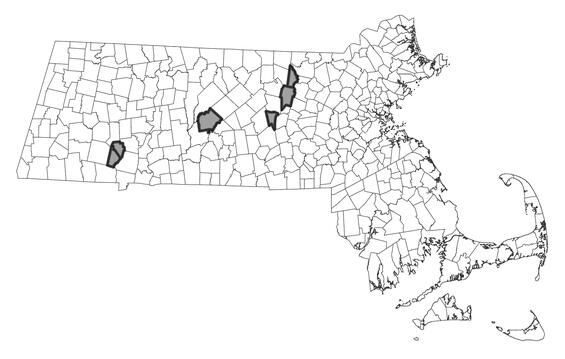- Scientific name: Cyperus houghtonii
- Species of Greatest Conservation Need (MA State Wildlife Action Plan)
- Endangered (MA Endangered Species Act)
Description
Houghton’s flatsedge is a perennial plant of dry, often sandy, soil. A member of the sedge family (Cyperaceae), it has triangular stems and is 2-6 dm (8 in-2 ft) tall. Its inflorescences are borne at the top of the stems. Each inflorescence branches from a central point, so that the inflorescence resembles the spokes of an umbrella. Accordingly, some members of this genus are called “umbrella-sedges.”
Identification of species in the genus Cyperus can be difficult, and a technical manual should be consulted. Like all members of the genus Cyperus, Houghton’s flatsedge has elongate clusters of small, inconspicuous flowers and subtending scales, called “spikelets”. In this genus, the flowers and associated scales are arranged in two vertical rows along the inflorescence stem axis, giving the flowering stems a flattened appearance (“distichously” arranged). In Houghton’s flatsedge, each spikelet is ascending and is 5- to 15-flowered. The scales are rotund, 2-2.5 mm (0.08-0.1 in) long, many-nerved, and tipped with a very short, sharp, slender point. The achenes (one-seeded fruits) are trigonous (three sided) with concave faces. They are 1.5-2 mm (0.06-0.08 in) long.
Twenty species of flatsedge have been documented from Massachusetts. Many have inflorescences which do not closely resemble umbrella spokes because the spikelets diverge from many points along a central axis, rather than all from one central point. The flatsedge most likely to be confused with Houghton’s flatsedge in upland, dry, sandy habitats is the sand flatsedge (Cyperus lupulinus). The sand flatsedge differs from Houghton’s flatsedge in that the longest bract beneath the inflorescence is horizontal to reflexed, compared to ascending in Houghton’s flatsedge. In addition, the achene sides are markedly concave in Houghton’s flatsedge, and not or only slightly so in sand flatsedge. Dune flatsedge (Cyperus grayi) is another dry-land flatsedge that could be confused with Houghton’s flatsedge, although as its name suggests, its habitats are typically coastal; Houghton’s flatsedge is found along the coast only atypically. Like the sand flatsedge, the dune flatsedge does not have the markedly concave achene sides of Houghton’s flatsedge.
Life cycle and behavior
This is a perennial sedge.
Population status
Houghton’s flatsedge is listed under the Massachusetts Endangered Species Act as Endangered. All listed species are protected from killing, collecting, possessing, or sale and from activities that would destroy habitat and thus directly or indirectly cause mortality or disrupt critical behaviors. The MassWildlife’s Natural Heritage & Endangered Species Program database has 14 records from 6 counties: Berkshire, Franklin, Hampden, Middlesex, Norfolk, and Worcester. Seven of these records have been observed within the last 25 years.
Distribution and abundance
The documented range of Houghton’s flatsedge extends from Massachusetts, New Hampshire, Vermont and southern Quebec to Minnesota and northwestern Indiana. Isolated, disjunct populations occur in northern Virginia and eastern West Virginia.

Distribution in Massachusetts
1999-2024
Based on records in the Natural Heritage Database
Habitat
Unlike most flatsedges, which prefer shores of ponds and rivers and moist ground, Houghton’s flatsedge prefers dry soil conditions. In the northern portion of its range, it is commonly found growing with jack pine (Pinus banksiana). Habitats in Massachusetts include dry, open, rocky summits; the exposed fine sand of a large esker with heavily eroded sand gullies; and a broad, gently sloping sandplain. Associated herbaceous species include horseweed (Conyza canadensis var. canadensis), sand-sedge (Bulbostylis capillaris), dune flatsedge (Cyperus grayi), blue curls (Trichostema dichotomum), little bluestem (Schizachyrium scoparium), and wild lupine (Lupinus perennis). Associated woody species are red pine (Pinus resinosa), black birch (Betula lenta), and scrub oak (Quercus ilicifolia).
Healthy habitats are vital for supporting native wildlife and plants. Explore habitats and learn about conservation and restoration in Massachusetts.
Threats
Suppression of natural disturbance regimes (e.g., wildfire), which could be followed by succession, is likely the greatest threat to this species in Massachusetts.
Conservation
As for many rare species, exact needs for management of Houghton’s flatsedge are not known. The following comments are based primarily on observations of populations in Massachusetts. Several of Massachusetts’ populations occur on circumneutral rocky summits and rock outcrops. These open communities are dominated by grasses, sedges, and herbaceous plants. Grazing and fire may contribute to keeping these areas open.
Contact
| Date published: | April 15, 2025 |
|---|